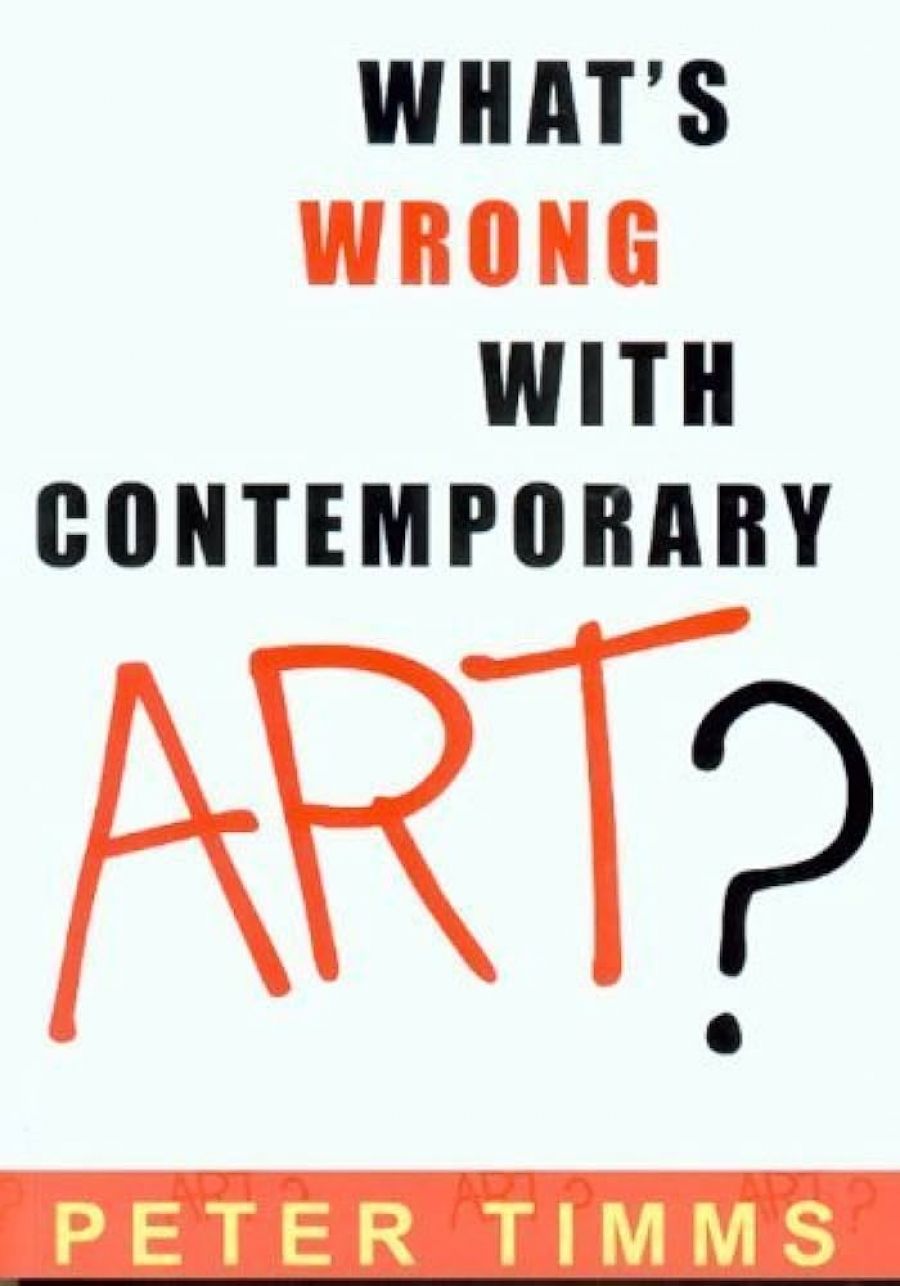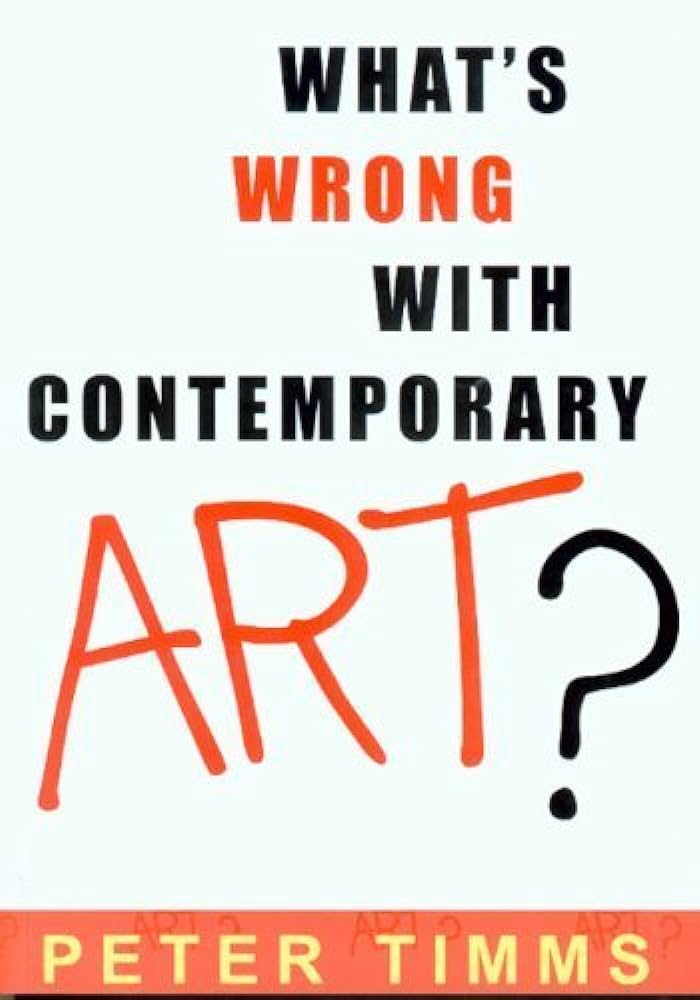
- Free Article: No
- Contents Category: Art
- Review Article: Yes
- Article Title: Two Bob Each Way
- Online Only: No
- Custom Highlight Text:
Peter Timms is ‘dismayed’ by the state of contemporary art and by the hype that surrounds it and the reality of the experience. He has written a book mired in exasperation and frustration. It is not hard to share Timms’s sentiments. Visit any sizeable biennale-type exhibition and you are engulfed in flickering videos in shrouded rooms, installations of more or less hermetic appeal, large-scale photographs – these often prove to be the most interesting – scratchy ‘anti-drawings’ and a handful of desultory paintings. Noise is ‘in’, too. ‘Biennale art’ is the term frequently used to describe the phenomenon.
Quite who is to blame for this occupies much of the first half of Timms’s book. Artists hell-bent on having careers rather than seeking vocations are part of the problem, and so are curators of contemporary art who nourish the artist’s every need. Art schools are next, where cultural theory has replaced the teaching of art history. The superficialities and the susceptibility to trendiness in the Australia Council are further contributors.
- Book 1 Title: What’s wrong with contemporary art?
- Book 1 Biblio: UNSW Press, $29.95 pb, 184pp
- Book 1 Cover Small (400 x 600):

- Book 1 Cover (800 x 1200):

Quite who is to blame for this occupies much of the first half of Timms’s book. Artists hell-bent on having careers rather than seeking vocations are part of the problem, and so are curators of contemporary art who nourish the artist’s every need. Art schools are next, where cultural theory has replaced the teaching of art history. The superficialities and the susceptibility to trendiness in the Australia Council are further contributors.
For Timms, however, the really big bad wolf in the fold of contemporary art is the Market. He admits that biennale art is hard to sell privately. Who wants videos, installations, scratchy drawings etc. in their dining room? (In the United States, there are quite avid collectors for such material, but they tend to create their own museums to house them.) The Market means more than simply the bourse where works of art are bought and sold. The Market is the entire system for Timms – the publicity, the money, the hype, the fame, the institutions – the whole nine yards. But after tut-tutting about the increasing size of sculpture prizes in Australia – the McClelland Gallery topped them at $100,000 last year – Timms rushes in to save the day, and that opening phrase becomes habitual throughout the book: ‘This is not to say, of course, that artists shouldn’t be going where the money is. Good luck to them. We should, however, be questioning the extent to which we want real-estate developers to determine the course of art practice.’ Next paragraph, the same contradictory, self-exculpating gesture appears: ‘Nor do I mean to imply any conspiracy; only to point out there is a general consensus among dealers, curators, art educators, critics and arts bureaucrats about which kinds of art are important and which are not.’
This see-sawing discourse – two bob each way on all the issues – characterises the entire book, and robs it of cogency and coherence. Having trawled through the vicissitudes of the Market with Timms, we are told in the following chapter: ‘In reality, the economics of the art world are closer to the old Soviet model than to anything resembling capitalist mass marketing.’
The idea that these contradictions are subtle qualifications to his arguments does not pass the joke test. Let me go again: Timms oracularly informs us that: ‘Despite what they might claim, artists rarely, if ever, explore or investigate issues of social, political or scientific concern.’ Turn over two pages and you read of Peter Dombrovskis, ‘whose famous photograph of a bend in the Franklin River helped save that wild waterway from the depredations of the Hydro-Electric Commission in the seventies’. Indeed, wilderness photography – ‘a defiantly traditionalist artform’ – has ‘gained so much art world credibility through its association with left-wing politics’.
Elsewhere, the tone swings giddily from the voice of nanny – ‘We cannot just take artists or critics or curators at face value. We must make a judgment about whether the subject they are dealing with is one they have mastered, or at least properly thought through’ – to pure bathos – ‘While we might wake up at 3 am worrying about whether we left the oven on, we are just as likely to wake up and worry about the nature of God.’
How and why does a person of Timms’s experience in the art world – a past director of two public galleries, a curator, an editor of Art Monthly, art critic for The Age – come to write such a nonsensical book? What is lacking at the heart of his enterprise is a commanding critical view of the scene he surveys. He likes and admires wholeheartedly the ceramicists Col Levy and Gwyn Hanssen Pigott. Elsewhere, we are much less clear of his predilections or aversions. An artist such as Patricia Piccinini ties him up in knots. Her Young family (2002) has ‘conceptual complexity. The problem, however, is that conceptual complexity is not brought to full realization by the artist, since she does not make these things herself, but employs a team of technicians and fabricators.’ Thus she takes her cue from ‘twentieth-century industrial design practice, [and] makes many people uneasy, and for good reason’. If that slide rule were laid across late twentieth-century art, we would be without some impressive bodies of work from Sol Le Witt’s wall drawings to Damien Hirst’s constructions. The model of artistic integrity for Timms is evidently the studio potter such as Col Levy who draws his clay and crushes his rocks and spins his pots.
But then, true to form, Timms reverses himself and redeems Piccinini from ‘uneasiness’. In the closing paragraphs of the book, we learn that Young family is ‘suggestive and allusive … It engages our imagination by means of inventiveness and a sense of fun that leads us on to thought and contemplation.’ Personally, the work I’ve seen by Piccinini threatens to give slickness a bad name.
Good criticism springs from the affirmations of taste, not negation or its twin cousins, exasperation and frustration. Good criticism makes aesthetic judgments, and its quality is sustained by the critic’s insights into the bases of those judgments. When Timms formulates his aesthetic credo, he is embarrassingly mushy. He believes ‘the arts to be about the exploration of philosophical ideas, metaphysical enquiry, the formulation of cultural – as distinct from nationalist – aspirations, the working through of founding mythologies or collective moral values’.
This book dips below the Plimsoll line of critical discourse. It is not helped by Timms’s split-infinitive prose, immunity to the sound of clichés (‘two sides of the same coin’, magazines that fear ‘to bite the hand that feeds them’, ‘howls of outrage’) and sloppiness. Anselm Kiefer is misspelt twice – once in the text and once in the index. Norman Rosenthal, long-serving secretary for exhibitions at the Royal Academy, is promoted to being the director of the National Gallery. Laurence Sterne becomes ‘Lawrence Stern’. It is all most unfortunate.


Comments powered by CComment